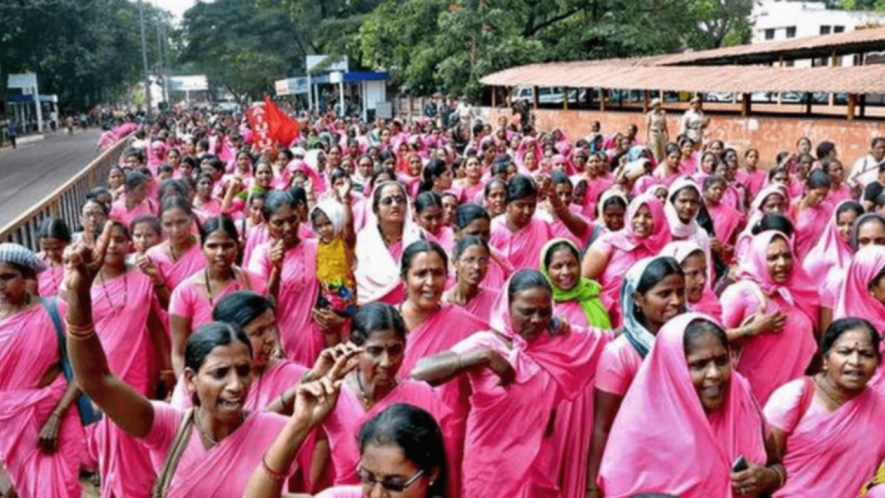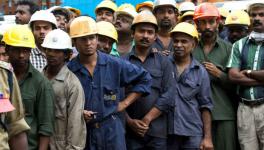Assam ASHAs Stare at Bleak Future

Image for representational purpose.
On May 23, Accredited Social Health Activists (ASHAs) of Assam started a four-day statewide protest demanding recognition, salary instead of the honorarium and clearance of one-time payment for retired workers and helpers.
The protesters, under the All Assam Anganwadi Workers’ and Helpers’ Association (ASAWHA), All India Federation of Anganwadi Workers and Helpers (AIFAWH, Assam)— affiliated to CITU—also demanded provident fund (PF) and pension, infrastructural development of Anganwadi Centres, and recognition for the mini-workers as full-fledged workers.
Similar large-scale protests were also reported in north and south India.
More than two months after the Assam protest, the demands haven’t been met with ASHAs as vulnerable as ever, EastMojo reported.
Of 13,89,110 Anganwadi Centres countrywide as of 2021, Assam has 61,715, involving more than 1.2 lakh workers and helpers. Anganwadi workers are part of the Integrated Child Development Scheme (ICDS), which addresses malnutrition, health and development needs of young children, and pregnant and nursing mothers.
Jupitora Nath, an Anganwadi worker in her late 40s part of a protest outside the District Social Welfare Office in Guwahati’s Beltola neighbourhood, told EastMojo said that they have been protesting since 2015 but to no avail. But “we are not going to back down this time; the government must listen to our cries”, she added.
Anima Gogoi (39), an Anganwadi helper protesting in Guwahati, sarcastically replied when asked how she managed her household with the honorarium, “Are you trying to embarrass me. How do you run a household with just Rs 3,000? Even a gas cylinder costs Rs 1,000. What’s left?”
Anganwadi workers and mini-workers receive Rs 6,500 and Rs 4,500, respectively, including Rs 4,500 and Rs 3,500, respectively, the Centre pays workers and mini-workers and a meagre Rs 2,250 for helpers—one of the lowest state allowances paid by a state.
According to Central government data, Anganwadi workers and helpers in Goa, Andhra Pradesh, Haryana and Karnataka receive some of the highest honoraria (minus the additional allowance they receive from the Centre). The Delhi government said in February 2022 that it pays the highest allowance to these worker and helpers.
“It is much more difficult for northeastern states without the Centre’s support,” according to economist Dipa Sinha, assistant professor at the School of Liberal Studies, Dr BR Ambedkar University, Delhi.
“For several Central schemes, the ratio of salary contribution is 50:50 or 60:40 for other states. For Assam and other northeastern states, it is 90% the Centre and 10% state.”
In Assam, the situation Anganwadi workers and helpers who are sole breadwinners, widowed or separated is worse.
Johura Begum (44), from Uttar Chamarali, a revenue village in Hojai, has been an Anganwadi worker for more than two decades. The mother of three is the only breadwinner of her family as her husband cannot work due to health reasons.
She has been trying to complete the construction of her two-room concrete house since 2013. “I hardly manage two meals a day. Constructing the house will remain a dream,” she said.
Two of her elder sons work as daily wagers to support the family. “I even forced my children to drop out of school. Even if I had worked as a house help, I would have earned better wages,” she added.
The CITU has been supporting the demands of Anganwadi workers and helpers. CITU general secretary Tapan Sen said that the trade union at the 44th sitting of the Indian Labour Conference in 2015 recommended that ICDS workers must be recognised as government workers and “paid minimum wages as per the Minimum Wages Act, 1948”.
“According to the Minimum Wages Advisory Board, today considering the long hours of shifts they put in and inflation, then each worker should be paid, at least, Rs 800 daily wage. Unfortunately, these recommendations have not been implemented,” he told EastMojo.
Do everything, ask nothing
Anganwadi workers are only required to perform six services under the ambit of ICDS, but they are often tasked to perform activities not prescribed in ICDS, according to Sahida Begum, who was demonstrating in Hojai’s Shankerdev Nager on the last day of the protest.
Sahida said that they are tasked with performing other duties—ranging from block-level office works, National Register of Citizens, COVID-19, Ayushman Bharat and Orunodoi to even the National Education Policy.
“We have to work 14-15 hours to manage the workload. We feel like manual workers now,” she added.
Workers have to log online via an App called Poshan Tracker installed on government-supplied phones to record attendance, activities, and register children’s weight and nutrition, etc.
Though the workers log out at 12 pm, Sahida said, they have to check on nursing mothers and pregnant women as per the ICDS manual. Often, they stay up the whole night to wrap up their work and maintain, at least, 20 registers. “We spend day in and day out looking after the nourishment of these children. We are responsible for their health. But we have no time for our nourishment,” said Sahida. “Even if we fall sick, we neither have the money nor the time to see a doctor.”
The smartphones—from two brands Lava and Panasonic—often crash or malfunction, adding to increased working hours. “These phones are useless. We call them ghost phones because they turn on and turn off on their own,” Pratima Saha Roy, an Anganwadi worker, said.
In 2021, chief minister Himanta Biswa Sarma announced a one-time financial assistance to Anganwadi workers and helpers retiring at 60. As of May, the state had more than 3,000 retired workers and helpers. According to ASAWHA general secretary Indira Newar, only around 800 workers and helpers have received the benefit.
Manju Cooch, a retired worker from Biswanath Charali, is unmarried and hasn’t received the benefit. Her sudden retirement in last April shocked her. “It was so sudden. It was communicated to me in the wee hours.”
Assam’s Anganwadi workers and helpers have been pleading with the government to increase the retirement age. Since they are called “voluntary workers”, Newar said, the same parameters of retirement don’t apply to them.
The Supreme Court in May set aside the Tripura High Court’s order to increase the retirement age of Anganwadi workers from 60 to 65 years.
Retired ICDS workers are not paid pension, PF or gratuity despite an apex court judgement last year stating that they are entitled to gratuity under the Payment of Gratuity Act, 1972.
Mukesh Chandra Sahu, principal secretary to the Department of Women and Child Development, refused to comment.
The Ministry of Women and Child Development describes them as “honorary workers from the local community” who render their services “on a part-time basis in the area of child care and protection”. Even for primary healthcare and educational needs, they are not recognised as government workers.
However, Sinha argued that categorising them as “honorary workers” is injustice when more than 80 million Indians benefit from them. “When the ICDS started in 1975, the idea was community-based childcare by women, and that is how the name ‘Anganwadi’ came to be. But these workers and helpers have been entrusted with an increasing amount of additional responsibilities ever since,” she said.
Get the latest reports & analysis with people's perspective on Protests, movements & deep analytical videos, discussions of the current affairs in your Telegram app. Subscribe to NewsClick's Telegram channel & get Real-Time updates on stories, as they get published on our website.
























